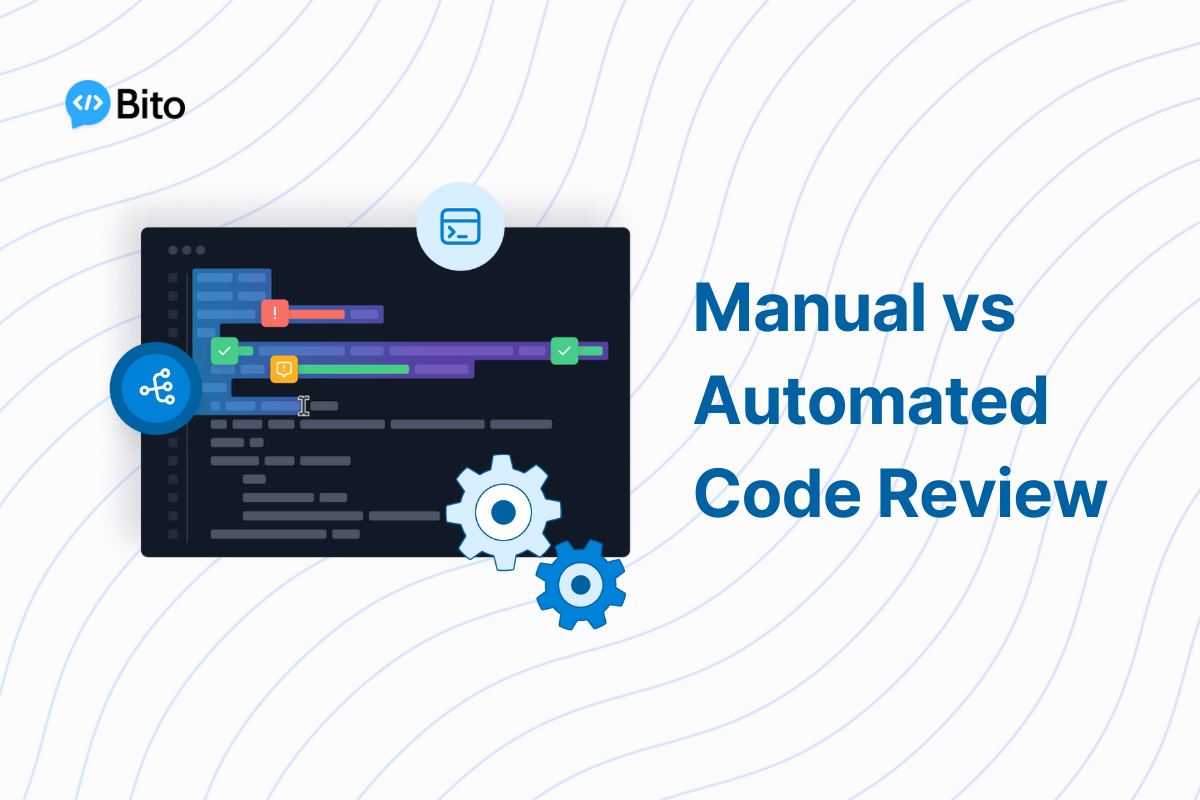Code reviews are a critical part of the software development process. They ensure code quality, identify security vulnerabilities, and promote best practices. However, traditional manual code reviews can be slow, inconsistent, and struggle to scale with growing codebases and teams.
In this article, we will look at how AI-powered code review tools are automating the entire code review process for startups and enterprises.
Automate code reviews with Bito’s AI Code Review Agent.
The Bottleneck of Manual Reviews
Manual code reviews are time-consuming for both developers and reviewers, especially for large codebases with frequent changes. Different reviewers may find varying issues due to experience and subjectivity.
Human reviewers are susceptible to bias based on their individual coding styles and preferences. This subjectivity can lead to inconsistencies in the review process and potentially hinder the adoption of suggested improvements.
Additionally, as development teams and codebases grow, the time and resources required for effective manual reviews can become increasingly difficult to manage. This can lead to rushed reviews or a reduction in their overall effectiveness.
The solution is to integrate AI-powered automated code review tools in your workflow.
What is Automated Code Review?
Automated code review is the process of using software tools to analyze source code for bugs, security vulnerabilities, and adherence to coding standards. It acts as an assistant to human code reviewers, who are still essential for the overall process.
Since the advent of Generative AI (GenAI), there has been a surge in AI-powered tools that leverage Large Language Models (LLMs) alongside advanced Artificial Intelligence (AI) techniques such as Retrieval-augmented generation (RAG), Vector Embeddings, etc. to understand your code and provide context-aware suggestions within minutes.
AI-powered code review tools can also be integrated with existing tools you use in your workflow, such as static code analysis, issue tracking software, and much more. Additionally, they learn from existing codebases and best practices to recommend high-quality relevant improvements.
For example, Bito’s AI Code Review Agent leverages GPT-4 as well as machine learning techniques to automatically find issues in pull/merge requests in GitHub or GitLab and provide high-quality fixes.
Advantages of Automated Code Review
Speed and Efficiency: Compared to manual reviews, automated tools offer significant speed advantages. They can analyze large codebases in a matter of minutes, providing immediate feedback to developers and streamlining the development process.
Consistency: Automated tools enforce coding standards and best practices consistently across the codebase. This helps to eliminate human bias and ensures that common coding errors and vulnerabilities are caught early in the development cycle.
Scalability: Automated code review tools are easily scalable. They can handle large codebases with frequent changes effectively, making them well-suited for modern development workflows with continuous integration and continuous delivery (CI/CD) pipelines.
Bito’s AI Code Review Agent
Bito’s AI Code Review Agent represents a significant leap forward in automated code analysis and review. This tool is expert at examining every Pull/Merge Request in a repository, swiftly identifying issues such as errors, code smells, and security vulnerabilities.
Its integration with common git platforms like GitHub, GitLab, and Bitbucket, ensures a seamless blend into existing workflows.
The utilization of Bito’s Native Code RAG (Retrieval-Augmented Generation) technology enables a deeper, more context-aware understanding of codebases. This results in highly relevant and personalized feedback, enhancing the code review process’s efficiency.
What sets Bito’s AI Code Review Agent apart is its adaptability and customization options. It’s designed to align with diverse team workflows and specific needs.
Additionally, Bito offers the ability to create custom AI Agents using their open framework. These custom agents can understand your code, interact with an organization’s specific data and tools, and even be shared globally. This flexibility positions Bito’s tool as a highly versatile solution in the evolving landscape of code review and management.
Features
- PR Summary: Quick, comprehensive overviews of pull requests.
- Review Effort Estimation: Evaluates PR complexity for better scheduling.
- AI Code Review: Assesses security, performance, scalability, optimization, impact on existing features, code structure, and coding standards.
- Tailored Code Suggestions: Precise, line-specific improvement suggestions.
- Static Code Analysis: In-depth analysis with tools like fbinfer and Sonar.
- Security Vulnerability Check: Uses tools like OWASP Dependency-Check for detecting severe security flaws.
- Feedback Integration: Directly posts comments in PRs/MRs.
- Real-Time Feedback: (Upcoming) Instant code feedback in IDE.
Pricing Details
- Free plan: Yes! Start your 14-day free trial
- Paid plan: $15 per user per month (billed monthly)
Practical Examples
A critical security patch needs to be applied urgently across a massive codebase. Manually reviewing every line of code to ensure the patch is applied correctly would be incredibly time-consuming and could delay the deployment. In this scenario, an automated code review tool like Bito’s AI Code Review Agent can be highly beneficial.
By scanning the codebase for vulnerabilities related to the specific patch, the tool can quickly identify potential conflicts or areas requiring additional attention. This allows developers to focus their manual review efforts on these areas, expediting the secure deployment of the patch.
The Right Approach: Combine Manual and Automated Code Reviews
By understanding the strengths and weaknesses of both manual and automated code review approaches, development teams can leverage their combined power for optimal results. Here’s how:
- Leveraging Automation for Efficiency: Automated code review tools are ideal for catching common errors, enforcing coding standards, and providing a baseline level of code quality. This frees up valuable developer time for manual reviews, allowing them to focus on more complex issues, code design, and adherence to project goals.
- Manual Reviews for Deep Dives: After the automated review has identified potential issues, manual reviews become even more valuable. Developers can delve deeper into flagged areas, assess their significance, and suggest targeted improvements. The context awareness and deep code understanding provided by manual reviews ensure that the code not only functions correctly but also adheres to best practices and aligns with the overall project vision.
- Prioritization and Focus: When used together, automated and manual reviews create a layered approach to code quality. Automated tools highlight potential issues, allowing manual reviewers to prioritize their efforts on the most critical areas. This ensures that time-consuming manual reviews are focused on areas with the greatest potential impact on code quality and maintainability.
Building a Robust Review Process
To achieve optimal results, development teams should establish a well-defined code review process that integrates both manual and automated approaches. Here are some key considerations:
- Tool Selection: Choosing the right automated code review tools is vital. Tools should be compatible with the team’s development environment and programming languages. Additionally, the toolset should be customizable to align with the team’s specific coding standards and best practices.
- Integration with Development Workflow: Integrate automated code review tools seamlessly into the development workflow, ideally as part of the CI/CD pipeline. This allows for early detection and correction of issues, preventing them from propagating to later stages of development.
- Review Guidelines and Training: Establish clear guidelines for both manual and automated code reviews. These guidelines should outline the scope of reviews, expectations for severity levels of flagged issues, and best practices for providing constructive feedback. Additionally, train developers on effective code review techniques, fostering a collaborative and knowledge-sharing environment.
Conclusion
Manual code reviews are slow, inconsistent, and miss errors, especially in large codebases. They also have limited scope. However, AI-powered automated code review tools offer a solution to these problems.
AI supercharges code reviews by efficiently handling massive codebases, ensuring effortless project scaling. It enforces consistent coding standards, eliminating inconsistencies between reviewers. This, combined with immediate feedback on code changes, dramatically improves timeliness.
AI also takes an active role in reducing human error through automatic detection of coding issues. But AI’s power extends beyond that. It analyzes code for hidden problems, offering a broader view of potential issues that might escape human reviewers.
However, it’s important to remember that AI is not a perfect solution. AI may struggle to understand the specific goals behind the code, limiting its ability to identify certain types of issues.
The most effective approach combines the strengths of both manual and AI-powered reviews. Human reviewers can focus on complex logic, design decisions, and areas where judgment is most valuable. Meanwhile, AI can automate repetitive tasks, identify potential issues, and ensure consistent code quality. This collaborative approach can significantly improve software quality, development speed, and developer productivity.






